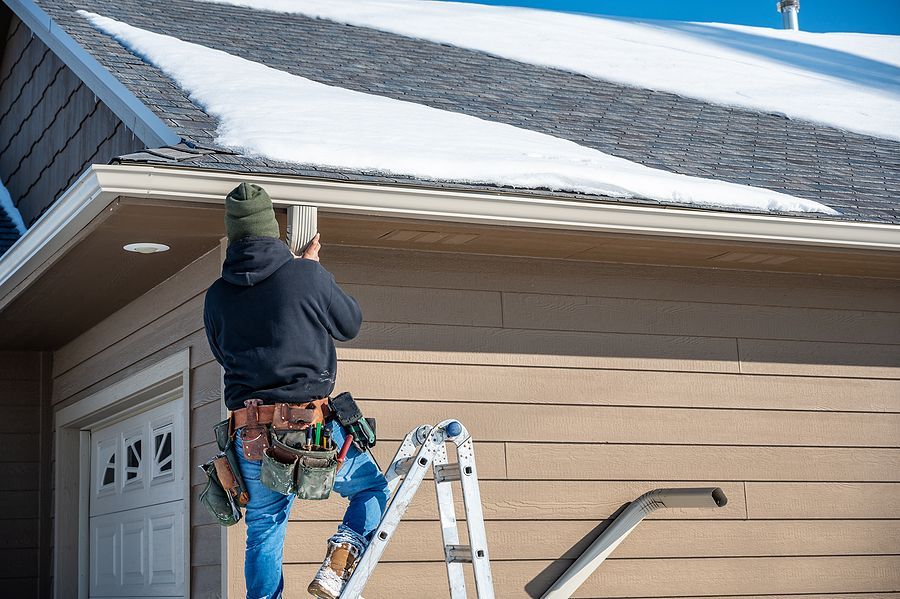
-
What are some signs that your gutters need to be repaired or replaced?
1. Gaps
Your gutters should not have large gaps between them and the house. These gutters can be repaired by adding new screw-in hidden hangers to re-secure the existing gutters back to the fascia board.
2. Cracks or fractures
If there is a visible cut in your gutters, then water will leak out onto your fascia, siding, windows, and even the interior drywalls of your home. Rainwater will not be effectively directed away from your home
s foundation as it should. Also, small cracks can eventually turn into large fractures, creating even greater problems for your entire drainage system in the future. Cracks or fractures in the gutter will require gutter replacement as a long-term solution.
3. Standing water
Standing water could indicate that there is some sort of blockage either in the gutter and/or the downspout. It could also mean that the gutter itself is not sloped or pitched properly. Both of which can be repaired or fixed and do not require replacing the gutter system.
4. Sagging gutters
A gutter that is bowing or pulling away from the home indicates that your gutters
brackets are loose and will require gutter repair. The wood behind the gutter should also be inspected for any damage as this could be the cause of the gutter becoming loose. If the wood is damaged, then the existing gutter will need to be removed and re-installed in order to replace the damaged wood.
5. Peeling paint
When house paint peels, it
s often due to constant moisture. Most modern paint can withstand the natural elements. If paint begins to peel or flake off the home, then it is likely that the gutter system may be overflowing or leaking. Overflowing and leaky gutters can usually be repaired.
6. Rust
Some gutter materials may succumb to rust because of age or possibly constant standing water inside of the gutter caused by a lack of slope or pitch in the gutter. While the gutters may continue to work for some time, it is best to replace these gutters before the rusted metal shatters and breaks.
7. Water damage marks
Discoloration on the exterior of your siding, windows, fascia, or downspouts may indicate that your gutters are not functioning properly. If there is any discoloration, it is best to have your gutters inspected because they are likely overflowing and/or leaking which could be the source of the discoloration. Overflowing and leaky gutters can usually be repaired.
8. Mold
If mold is present in your basement or close to the top of your exteriors, then your gutter system may be working improperly. This is often caused by overflowing and/or leaky gutter systems. Overflowing and leaky gutters can usually be fixed or repaired.
9. Soil erosion & Foundation problems
Soil erosion can not only be bad for your lawn, but it could expose your foundation to water damage. This can sometimes be caused by overflowing and/or leaky gutters. Some gutters will require valley guards/water diverters to prevent splash-over or overflow. Soil erosion can also be caused by misplacement of downspouts. Some downspouts carry higher amounts of water than others. This will sometimes require additional drainage pipes and/or splash blocks. These problems can often be solved with proper gutter repairs.
10. Overflowing water
When your downspouts are dispensing some water, but your gutters are still overflowing, you may need gutter cleaning and/or gutter repair. Overflowing could be a sign of debris accumulation, poor installation, improperly sloped, and/or incorrect sized gutters that are far too narrow for your home.
11. Unexplained nails or screws
If you see nails or screws in your yard next to the roofing of your house, this could indicate that the gutter is working loose. If the gutter is loose, then it can be repaired but if the gutter eventually falls to the ground it may become damaged and will require gutter replacement.
12. Bent, Dented, or Creases
Dented gutters will typically require gutter replacement. If there is a slight bend, then it can usually be pulled out so it can continue to function, but it can never be re-shaped back to its original form. The dent will always remain visibly noticeable. If the gutter is dented and/or creased, then we always recommend replacing the gutter.
-
What are common causes of gutter damage?
Some of the most common causes of gutter damage include age, clogged gutters, poor installation, lack of maintenance, heavy snow and ice, water overflow, trees, animals, weather damage, and poor-quality materials. Understanding these causes can help you take steps to prevent gutter damage and keep your gutters in good condition.
-
Why are my gutters sagging?
Over time, your gutters can begin to sag and even start pulling away from your home. This usually occurs if your gutters haven't been cleaned or if water starts pooling within them; these add weight to the gutters, which weakens the fascia and causes the problem. The only solution for sagging gutters is to have a team of professionals replace the hardware. Then, once this problem is fixed, you
ll need to prevent the issue from happening again by ensuring you keep your gutters clean and clear of debris.
-
Can my gutter leaks be repaired?
One of the easiest ways to identify leaks is to check for dripping water while you clean out your gutters. If left in disrepair, leaks can cause damage to your roof, siding, and foundation. Leaky gutters can be fixed by removing the deteriorated sealant and/or sealing holes with caulk, from the inside. If holes are too big, or the area around them has become rusted, the best solution is to replace that segment of gutter.
-
Can you reposition or relocate my existing downspouts?
The point of gutters is to keep water from collecting around your home
s foundation; for them to do that, the downspouts have got to be positioned far enough from your home. If they're too close, water will still pool and can still potentially cause damage. Before the next big storm, make sure your downspouts extend at least two feet away from your exterior. If your downspouts are too close to your home, you may want to ask a professional gutter team to add extensions. This will give them the extra length needed to keep runoff water far from your foundation.
-
Can my existing gutters be re-pitched or re-sloped?
Gutters need a slight pitch for rainwater to reach the downspouts and drain properly. Proper sloping is necessary for the water to completely flow out of the system. If your gutter system doesn't have a decent pitch, you'll end up dealing with standing water; this can cause your gutters to rust or begin to sag. It can also turn your gutters into an attractive home for pests which comes with its own problems. If you notice standing water in your gutters or the water coming out of your downspout seems to wane, you should call a professional to have them check your pitch using a level.
